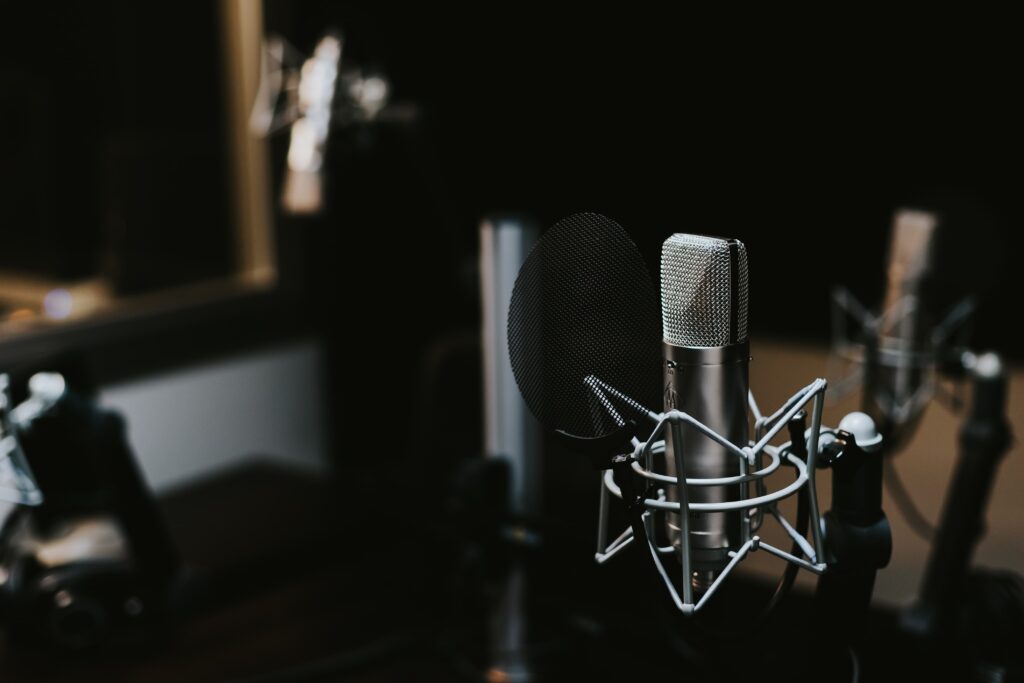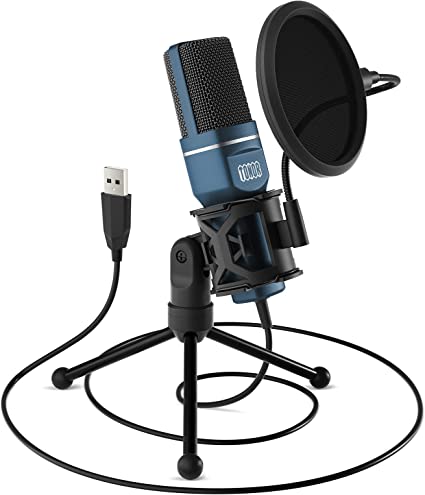E.C. Wente, an electrical engineer, made the first condenser microphone that worked well at the beginning of the 20th century. In 1916, Wente tried to get a patent for his “electrostatic microphone,” which used a thin metal diaphragm close to a metal plate to create an electric charge. This charge was then made stronger and used to make a sound signal.
In the 1960s and 1970s, solid-state electronics and low-cost, high-quality condenser microphones changed the recording industry in a big way. Today, condenser microphones are used in recording studios, broadcast studios, and other places where high-quality sound reproduction is needed.
What is a condenser microphone?
A condenser microphone is a type of microphone that turns sound waves into an electric current by suspending a thin, flexible diaphragm close to a metal plate. The diaphragm has a fixed electrical charge, and sound waves make the diaphragm vibrate, which changes the distance between the diaphragm and the metal plate. Because of this change in length, the electrical capacitance between the diaphragm and the plate changes. This change can be measured and used to make an electrical current that matches the original sound waves.
Condenser microphones are known for how well they can reproduce sound and how well they can pick up on small changes in sound waves. They are often used in studios for recording and broadcasting and other places where high-quality sound reproduction is needed. They are usually more expensive than dynamic microphones, which use a moving coil and magnet to turn sound waves into an electrical current.
Types of the condenser microphone
There are different kinds of condenser microphones, and each one is made for another task:
- Large-diaphragm condenser microphones: These have a diaphragm at least an inch in diameter and are known for their smooth, warm sound and ability to handle high sound pressure levels. They are often used to record vocals, acoustic instruments, and the sound of the drums coming from above.
- Small-diaphragm condenser microphones: These have a diaphragm less than one inch in diameter and are known for their fast transient response and ability to pick up high-frequency details. They are often used to record drums, stringed instruments, and vocals from a choir.
- Tube condenser microphones: The preamplifier circuit in these microphones are made of a vacuum tube, giving them a warm, old-school sound. They are often used in recording studios and on stages because they give the sound more depth and personality.
- USB condenser microphones: These have a USB port that lets them connect directly to a computer. This makes them good for podcasting, streaming, and home recording.
- Boundary condenser microphones: These are made to be mounted on a flat surface, like a conference table or lectern. They are often used in conference rooms and other places where a microphone needs to be hidden from view.
- Fet Microphone: The FET (field-effect transistor) microphone is a type of condenser microphone where the main part of the preamplifier circuit is a field-effect transistor (FET).
- Electret Microphone: The electret material is a type of polymer permanently charged by high voltage. This means the electret microphone doesn’t need an outside power source. Electret microphones are a type of microphone with a permanent charge because the electret material keeps its charge forever.
Features of a condenser microphone
Condenser microphones are different from other types of microphones in several ways:
- Diaphragm: A thin, flexible diaphragm with a fixed electrical charge is used in condenser microphones. When sound waves hit the diaphragm, it vibrates. This changes the electrical capacitance between the diaphragm and a metal plate, which makes an electric current that matches the sound waves.
- Polar patterns Different condenser microphones have different polar patterns, which tell you which way the microphone is pointing. Some common polar patterns for condenser microphones are omnidirectional, cardioid, and figure-eight. Omnidirectional microphones pick up sound equally well from all directions. In contrast, cardioid microphones are most sensitive to sound from right in front of the microphone (which is most sensitive to sound coming directly in front of and behind the microphone).
- Frequency response: The range of frequencies a microphone can playback is called its frequency response. Most condenser microphones can pick up a wider range of frequencies than dynamic microphones to pick up more subtle sounds and details.
- Sensitivity: Generally speaking, condenser microphones are more sensitive than dynamic microphones. This means that they can pick up even small changes in sound waves. This sensitivity can be both a strength and a weakness since it makes condenser microphones more likely to pick up background noise and other unwanted sounds.
- Dynamic range: The range of sound pressure levels that a microphone can handle without distorting is called its dynamic range. Most condenser microphones have a wider dynamic range than dynamic microphones. This means they can record a wider range of loudness without distorting the sound.
- Output impedance: The resistance of the electrical current made by a microphone is called its output impedance. Most condenser microphones have a lower output impedance than dynamic microphones, which makes them more sensitive to changes in load impedance (the resistance of the device or circuit to which the microphone is connected). This can affect the sound quality of the microphone, so it’s important to match the output impedance of the microphone to the load impedance of the device or circuit it’s connected to.
Conclusion
Condenser mics have flexible diaphragms that turn sound into electricity. They are great for picking up instruments, vocals, and other sounds because they respond quickly and can pick up a wide range of frequencies. Condenser mics are used both in the studio and on stage. Condensers can be big, small, have more than one pattern, or be tubes. Condenser mics are loud and need “phantom power” to work. Condenser mics are used for both live shows and recordings.




